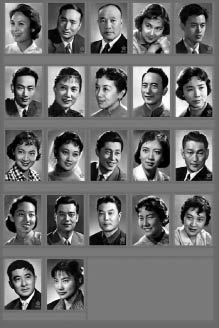Diverse Charms of Movie Icons over Time
By staff reporter LU RUCAI
POPULAR opinion on ideal feminine beauty and masculine good looks was a deciding factor for decades on which actors/actresses were most successful. The looks and roles of these movie icons reflected the prevailing values and attitudes of the time towards love and romance.
Today, a broader appreciation of beauty has engendered a constellation of film celebrities, each attractive in their distinct way.
The 1920s and 30s
Early film actors in China, such as Ruan Lingyu, Hu Die, Zhou Xuan, Zhao Dan, Jin Yan and scores of others, began their careers in theater or Chinese opera.
Delightfully dimpled, doe-eyed Hu Die (1908-1989), or Butterfly Hu, attended classes at the Shanghai Film School – first of its kind in China – at age 16. She was the first Chinese actress to become well known in the West.
 |
| Top 22 movie strars selected in 1962 |
Hu Die’s performance in the 1928 martial arts film Burning the Red Lotus Temple won her lasting stardom. By 1933, China’s first-ever public poll had named her Queen of Film. In 1935 Hu’s fame spread overseas when she attended the Moscow Film Festival as part of China’s first film delegation, which also included Peking Opera master Mei Lanfang. Hu Die displayed her versatility during her four-decade career in a wide range of roles, such as teacher, singer, prostitute and highborn lady. She received a special achievement award in 1986 at the Taipei Golden Horse Film Festival.
Zhou Xuan (1920-1957) was a favorite among intellectual circles. No classic beauty, the actress and singer had a refreshing, girl-next-door quality. Abandoned as an infant, Zhou’s adoptive parents enrolled her in singing and dancing classes when she was eight. Her singing role in Street Angel (1937), which displayed her distinctively sweet, lilting vocals, and powerful performance captured the hearts of millions of Chinese of the time, winning her the epithet “Golden Voice.” The role assured her sustained stardom. Two of the songs it featured, Four Seasons Song and The Wandering Songstress, are still popular today. Zhou Xuan took leading roles in 30 movies, among them Dong Xiaowan, Love Story of Su San and All-consuming Love.
The 40-instalment TV series in 2006 celebrating Zhou Xuan’s legendary life was a huge success.
Leading men Zhao Dan (1915-1980) and Jin Yan (1910-1983) embodied what was generally regarded in the 1930s as the ideal man. Originally a theatrical actor, Zhao Dan’s skilled portrayals and good looks singled him out and brought him stardom. He starred in the Spring Dream of the Lute (1932), Youngsters of the Time (1933), and Street Angel (1937).
Korean-born Jin Yan and his family immigrated to China to escape Japanese persecution when he was an infant. He became a Chinese citizen in 1921 and started his acting career in 1929. Tall and handsome, he was particularly popular among the youth. Among his best-known films are Three Modern Women, The Big Road and Soaring Aspiration. A 1934 poll survey named Jin “King of Film.” By the time he retired in 1962, Jin had starred in 46 movies. He is remembered as The Rudolph Valentino of Shanghai – an apt comparison, as in addition to being sex icons of the golden age of silent films, both also died of gastric problems.

